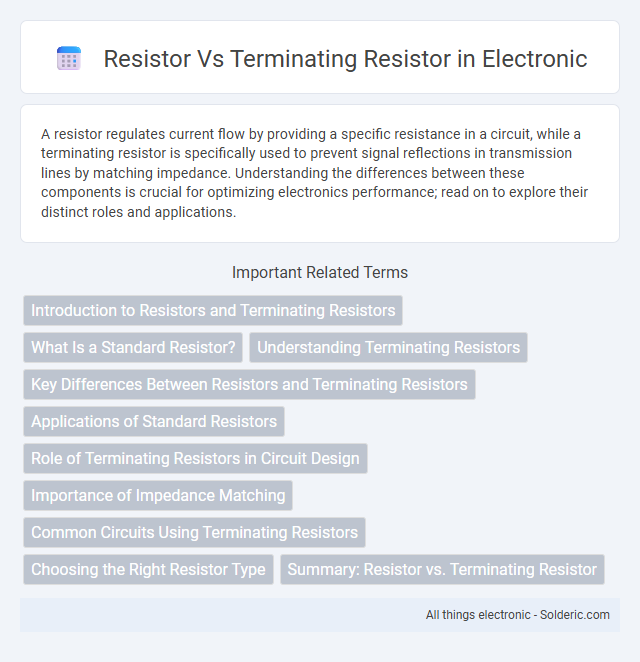A resistor regulates current flow by providing a specific resistance in a circuit, while a terminating resistor is specifically used to prevent signal reflections in transmission lines by matching impedance. Understanding the differences between these components is crucial for optimizing electronics performance; read on to explore their distinct roles and applications.
Comparison Table
| Feature | Resistor | Terminating Resistor |
|---|---|---|
| Function | Limits current and divides voltage | Prevents signal reflection in transmission lines |
| Placement | Anywhere in a circuit | At the end of a transmission line or bus |
| Resistance Value | Varies widely (ohms to megaohms) | Matches characteristic impedance (typically 50O to 120O) |
| Use Case | General circuit applications | Signal integrity in high-speed digital and RF circuits |
| Effect on Signal | Reduces current or voltage | Eliminates signal reflections and ringing |
Introduction to Resistors and Terminating Resistors
Resistors control electric current by providing a specific resistance, essential in managing voltage and protecting circuit components. Terminating resistors specifically match the impedance in transmission lines to minimize signal reflections and ensure proper signal integrity. Understanding the difference helps optimize your circuit design for both general resistance needs and high-frequency signal performance.
What Is a Standard Resistor?
A standard resistor is an electronic component designed to provide a specific, stable resistance value within a circuit, typically available in fixed resistance increments following E-series standards such as E12 or E24. It is used to control current flow and divide voltages in various applications, ensuring proper operation of electronic devices. Unlike terminating resistors, which are specially employed to match impedance and prevent signal reflections in transmission lines, standard resistors primarily handle current regulation without consideration for signal integrity.
Understanding Terminating Resistors
Terminating resistors are specialized resistors used to match the impedance of transmission lines and prevent signal reflections that can cause data errors in high-speed communication systems. Unlike standard resistors, terminating resistors are precisely calibrated to the characteristic impedance of the line, typically 50 or 75 ohms, ensuring signal integrity and minimizing noise. Proper use of terminating resistors is critical in applications such as Ethernet, CAN bus, and other serial communication protocols to maintain reliable data transmission and system performance.
Key Differences Between Resistors and Terminating Resistors
Resistors are passive electrical components designed to limit current and divide voltage in circuits, whereas terminating resistors specifically prevent signal reflections in transmission lines by matching impedance. Key differences include their function--general resistance versus impedance matching--and placement, with terminating resistors positioned at the end of communication lines. Understanding these distinctions ensures Your circuits maintain signal integrity and optimal performance.
Applications of Standard Resistors
Standard resistors are widely used in electronic circuits for current limiting, voltage division, and signal conditioning to ensure proper circuit functionality. In contrast, terminating resistors are specifically employed in high-speed data communication lines such as Ethernet and SCSI to prevent signal reflections and maintain signal integrity. Applications of standard resistors include power supplies, amplifiers, and measurement devices where precise resistance values are critical for accurate performance.
Role of Terminating Resistors in Circuit Design
Terminating resistors play a crucial role in circuit design by preventing signal reflections that cause data corruption and signal integrity issues, especially in high-speed digital and communication lines. Unlike standard resistors, terminating resistors are carefully matched to the characteristic impedance of a transmission line, ensuring proper signal absorption and minimizing electromagnetic interference. Your circuits achieve reliable performance and reduced noise when terminating resistors are correctly implemented at the ends of transmission lines.
Importance of Impedance Matching
Resistors serve basic current control functions, while terminating resistors are critical for impedance matching in signal transmission lines to prevent signal reflections and ensure signal integrity. Proper impedance matching with terminating resistors minimizes signal distortion and electromagnetic interference, especially in high-frequency circuits like HDMI or Ethernet connections. Using a carefully calculated terminating resistor at the end of a transmission line optimizes power transfer and maintains the fidelity of the transmitted signal.
Common Circuits Using Terminating Resistors
Terminating resistors are crucial in transmission line circuits, preventing signal reflections and ensuring impedance matching in systems like RS-485, CAN bus, and SCSI interfaces. Unlike standard resistors used for current limiting or voltage division, terminating resistors typically match the characteristic impedance of the transmission line, commonly 120 ohms in differential signaling applications. Proper implementation of terminating resistors enhances signal integrity and reduces electromagnetic interference in high-speed communication circuits.
Choosing the Right Resistor Type
Choosing the right resistor type depends on the specific application requirements, such as resistance value, power rating, and frequency performance. Standard resistors are suited for general current-limiting and voltage-dividing tasks, while terminating resistors are specialized components designed to match impedance and minimize signal reflections in high-speed communication lines. Ensuring your circuit includes the appropriate resistor type enhances performance, signal integrity, and overall reliability.
Summary: Resistor vs. Terminating Resistor
A resistor is a passive electrical component that limits current flow or divides voltage in circuits, while a terminating resistor specifically prevents signal reflections in transmission lines by matching impedance. Proper use of a terminating resistor enhances signal integrity in high-frequency communication systems, reducing noise and data errors. Your circuit's performance depends on selecting the correct type and value of resistor to meet electrical and signal requirements.
resistor vs terminating resistor Infographic

 solderic.com
solderic.com